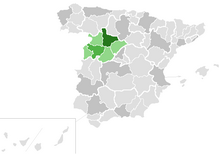Bishop of Salamanca
|
Diocese of Salamanca Dioecesis Salmantinus Diócesis de Salamanca |
|
|---|---|

|
|
| Location | |
| Country | Spain |
| Ecclesiastical province | Valladolid |
| Metropolitan | Valladolid |
| Statistics | |
| Area | 7,876 km2 (3,041 sq mi) |
| Population - Total - Catholics |
(as of 2010) 302,200 296,000 (97.9%) |
| Information | |
| Rite | Latin Rite |
| Cathedral | New Cathedral Basilica of Our Lady of the Siege in Salamanca |
| Co-cathedral | Old Cathedral of Our Lady in Salamanca |
| Current leadership | |
| Pope | Francis |
| Bishop | Carlos López Hernández |
| Metropolitan Archbishop | Ricardo Blázquez |
| Map | |
 |
|
| Website | |
| Website of the Diocese | |
The Roman Catholic Diocese of Salamanca (Latin: Salmantin(us)) is a diocese located in the city of Salamanca in the Ecclesiastical province of Valladolid in Spain.
The See of Salamanca is of unknown origin. St. Secundus is said to have founded the Diocese of Avila. Signatures of bishops of Salamanca are found in the Councils of Toledo; in the third council is that of Eleutherius; at the coronation of King Gondemar, that of Teveristus; in the fourth and sixth of Hiccila; in the seventh, eighth and tenth, of Egeretus; in the Provincial Council of Mérida (metropolis of Salamanca) the signature of Justus;in the twelfth of Toledo that of Providentius; in the thirteenth, fifteenth, and sixteenth, of Holemund, probably contemporaneous with the Muslim invasion.
Alfonso I the Catholic pushed his conquests as far as Salamanca, and Ordoño I of Asturias captured the city, but its bishops continued to reside in Asturias, where the Church of San Julian, outside the walls of Oviedo, was assigned to them. Bishop Quindulfus (802) signed a royal deed of gift. Ramiro II of León, who defeated the Muslim forces at Simancas, began to repopulate Salamanca. In 1102 the king's son-in-law Raymond, Count of Burgundy, and his wife Urraca of Castile, gave the churches of the city to Don Jerónimo, the count's master, and built the Cathedral of S. Maria. The celebrated bishop, comrade of the Cid Campeador, died in 1120 and was interred in the newly built basilica, to which he left the "Christ of the Battles" (Cristo de las Batallas).
...
Wikipedia
